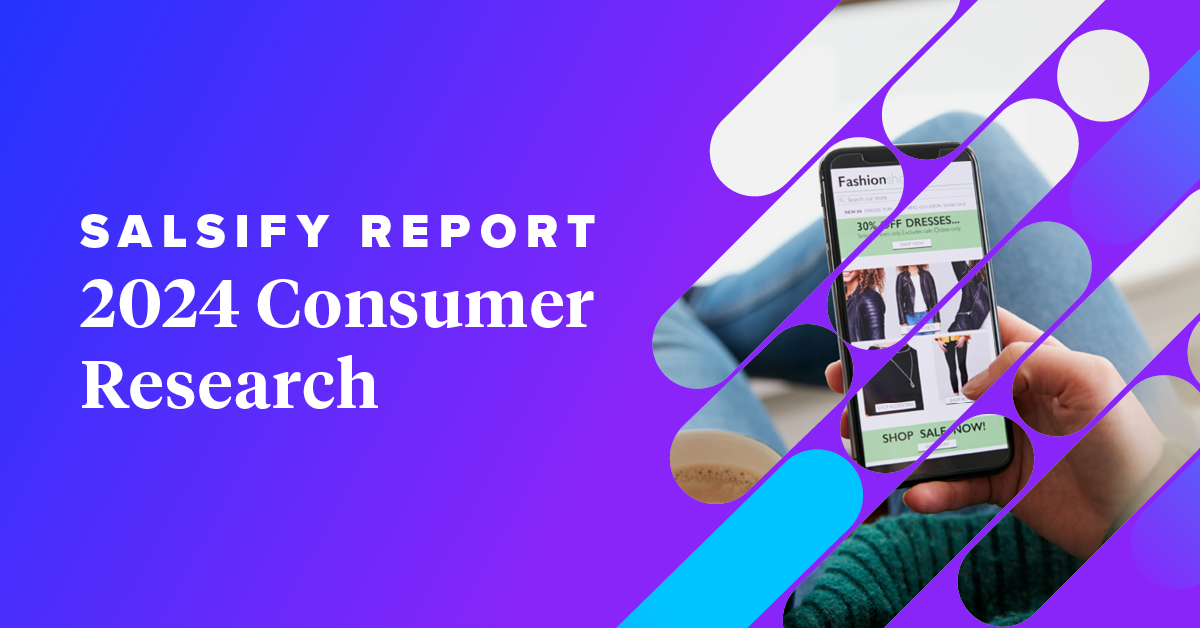How Phygital Transformation Creates Integrated Retail Experiences

Phygital: it might not be commonplace in your vocabulary — yet. It might even be one of those “future of now” phrases that somehow conjures up scenes from the future of yesterday, like the satisfying smack of hanging up on a Motorola Razr flip phone or the dancing silhouettes on iPod commercials.
But phygital is very much a modern concept, and it’s the latest phenomenon brands and retailers should embrace to better meet the demands of today’s consumers.
Learn what phygital is, what it means to undergo a phygital transformation, and gain examples and benefits of phygital retail for brands, retailers, and consumers alike.
What Does Phygital Mean?
Phygital is the combination of physical and digital, and phygital retail describes shopping experiences that combine in-store and online elements, resulting in more engaging omnichannel shopping experiences.
But why is it important to engage consumers? Aren’t there too many channels, options, and distractions for them to develop strong loyalty for any one brand or retailer?
Trust and loyalty can be attained, especially if your organization offers seamless shopping experiences or integrated retail across touch points that both respect and anticipate consumers’ needs.
These can include online touch points like a direct-to-consumer (DTC) site, a retailer like Amazon, and social media, or in-person touch points, such as a retailer like Target or a brick-and-mortar store.
If your goal is to stay on top of global retail trends and beat out the competition, you need to break down any barriers your organization may have between your digital (online, ecommerce) and physical (in-store, brick-and-mortar) offerings.
What’s the Difference Between Digital and Phygital Transformation?
Digital transformation means bringing the excellence of your brick-and-mortar operation online. In doing so, you’re ensuring your brand can be found and enjoyed even by those who are preoccupied during store hours or don’t always feel like leaving the house.
A phygital transformation, on the other hand, is an approach that will place your brand in front of more diverse customers at any point in their buying journey, as you’re applying equal effort to your online and offline offerings.
How Does Phygital Shopping Work?
Phygital shopping is the successful integration of the digital and physical existence of your brand through omnichannel experiences, providing consumers with a holistic view.
Building a truly omnichannel presence on the digital shelf, as well as engaging shopping experiences both in-store and online, are what make consumers do more than “just browse.”
Engaged consumers become paying customers. And, if you keep them engaged, it’ll hopefully blossom into a long-term commitment. After all, it’s not always easy to build a connection based on modern consumers’ high expectations.
How well this type of retail or shopping works for your business is based on how you equip or empower consumers to engage with your organization along their buying journey. For example, will you start with an in-store touch point and lead to an online one, or will you start with an online touch point and lead to an in-store one?
If you think this pinball-esque path to purchase sounds too complicated or isn’t something modern shoppers — who, largely, are obsessed with convenience — wouldn’t be interested in, the reality is, they already are.
Often, as much as they want convenience, they also want versatility.
Data Supporting the In-Store-to-Online Journey
According to Salsify’s “Consumer Research 2023” report, a survey of more than 6,000 shoppers in the U.S., Great Britain, France, Germany, and Australia, 68% still plan to shop in-store. However, 38% of these shoppers use mobile devices for product and price comparisons while in-store.
Additionally, shoppers in France (33%), the U.S. (37%), Great Britain (37%), Australia (41%), and Germany (45%) attribute the in-store shopping experience as a way to sustain brand loyalty.
Though you can wow shoppers online with enhanced content and high-quality visuals, it doesn’t always beat the full extent of the sights, sounds, and even smells of shopping in-store.
However, reviews are another factor that may lure shoppers back online to complete their buying journey. While there’s an off chance they can crowdsource from lurkers in-aisle, more than half of shoppers (57%) “read reviews while shopping in brick-and-mortar stores to assess potential purchases,” per PowerReviews.
And, once they’re reading the reviews, 51% of shoppers surveyed in France, 57% in Germany, 62% in Australia, and 72% in the U.S rely on consumer reviews found online to decide what to buy, according to Salsify consumer research.
Data Supporting the Online-to-In-Store Journey
According to Zippia, 63% of shopping journeys start online. It’s often when new product discovery occurs, as three of the top five ways shoppers discover new products are online, according to Salsify consumer research.
Additionally, however, consumers in the consideration phase might be exploring options online that they’re already familiar with, have browsed before, or to locate where they can check them out in person.
And, for shoppers ready to convert, their journey is likely to bring them into a store: 24% of shoppers in France, 25% of shoppers in the U.S., 34% of shoppers in Germany, 45% of shoppers in Great Britain, and 48% of shoppers in Australia are most likely to buy a product online and then pick it up in-store, according to Salsify consumer research.
Examples of Phygital Shopping
There’s a lot that can be said about achieving success on the digital shelf, but it essentially comes down to:
- Consumers want to find you where and when they want to find you; and
- It’s all about being on the right channel, for the right customer, at the right time.
Here are some examples of this type of shopping.
Online-to-in-Store Examples of Phygital Shopping
While shopping for your wedding dress online, you speak with an associate via chat to schedule an in-store appointment to try on a dress.
Or, while helping your dad compare laptop and tablet models online, you chat with a representative and schedule an appointment to check them out in-store to see which one he’ll like best (with the help of a patient expert).
In-Store-to-Online Examples of Phygital Shopping
While shopping for your wedding dress in-store, the boutique has a tablet set up to browse different styles of bridesmaids' dresses beyond the limited in-store offering. You find the exact cut and color your sister has been looking for, so you ship it directly to her.
Or, while in the other store, you scan a QR code to learn more about a waterproof case for your dad’s new tablet. You discover that his favorite team’s colorway is available online, but it isn’t in stock in the store — so you purchase it while standing in the aisle.
(Child of the year, you are!)
What’s the Difference Between Phygital Retail and Hybrid Shopping?
Again, phygital retail describes shopping experiences that integrate in-store and online elements, resulting in more engaging omnichannel shopping experiences. Again, it means physical and digital combined.
Hybrid shopping or hybrid retail experiences also involve elements of both digital and physical shopping, just like phygital shopping. The terms are essentially interchangeable.
If, however, at your organization, you’d like some delineation between the two, you could think of phygital meaning anything you offer that’s a completely integrated, omnichannel experience between your ecommerce and brick-and-mortar offerings.
Hybrid shopping, on the other hand, might be less of a pure combination (think shaken, not blended).
For example, in phygital retail, your wedding dress hunt led you directly to a store to try on the exact dress you saw online.
A hybrid shopping experience, on the other hand, might yield similar dresses that you could try on in-store, but not the exact one you had your eye on.
What Are the Benefits of Phygital for Brands and Retailers?
The benefits of this type of shopping for brands and retailers are only limited by their omnichannel strategy and commitment to technology. The limit doesn’t exist for brands and retailers that are dedicated to a true phygital transformation and seamless experiences across their digital shelf.
More Confidence From Teams and Stakeholders
Having a cohesive presence across your digital shelf will require a central source of truth for all of your product and brand information. If this information is aligned, your teams will be, too. (Not to mention, consumers will easily understand what you and your products are all about, no matter where they find you.)
Equipping your organization with a product experience management (PXM) tool can help you wrangle and organize content, including copy, photos, video, and more, as well as better distribute this information both internally and externally.
More Conversions With Customers
A phygital retail approach will find your brand in front of more diverse customers at any point in their buying journey.
Offering omnichannel methods of connecting with your organization also ensures that consumers can pick up where they left off or benefit from personalized recommendations and offers.
More Loyal Customers
Finally, the easier it is for consumers to find and get to know your organization across digital or physical touch points, the more likely it is they’ll deem you trustworthy and purchase-worthy.
Being equally accessible online and in-store will make it all the more desirable (and convenient) for consumers to incorporate your products into their routines. (Though, hopefully, they won’t need to buy too many wedding dresses.)
Let’s Get Phygital
Whether your organization fully leans into phygital retail or simply starts being more cognizant of related values, like crafting a cohesive presence across digital and physical touch points, the result will be that your brand will look fetch as heck on all of your channels and capture consumers’ attention — no matter if they’re prowling shopper centers like the future of yesterday or completing a purchase with just a tap like the future of now. *Slams Razr shut.*
The Complete Guide to Omnichannel Strategy for Commerce
For an overview of core concepts, insights from four key markets, a strategy guide, and more, download Salsify’s “Complete Guide to Omnichannel Strategy for Commerce.”
DOWNLOAD GUIDEWritten by: Yvonne Bertovich
Yvonne Bertovich (she/her) is an editor and writer at Salsify, reporting from Knoxville, Tennessee. With a longtime passion for research, she enjoys flexing her perspective on ecommerce, trends in consumer behavior, and health and wellness.
Recent Posts
Top Ecommerce Trends To Watch in 2025
Creative Real-World Examples of Zero-Party Data Collection From Brands and Retailers
Enter the Future of Shopping: The Age of the AI Shopping Assistant and Chatbot
Subscribe to the Below the Fold Newsletter
Standing out on the digital shelf starts with access to the latest industry content. Subscribe to Below the Fold, our monthly content newsletter, and join other commerce leaders.


.svg)